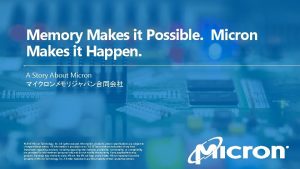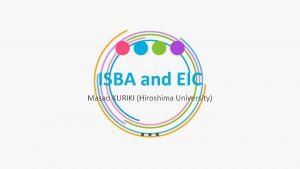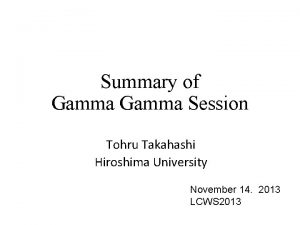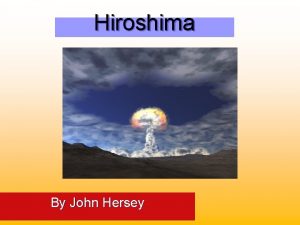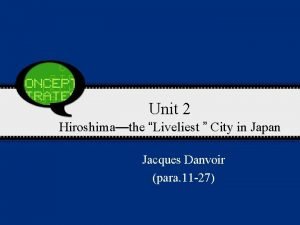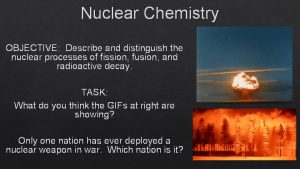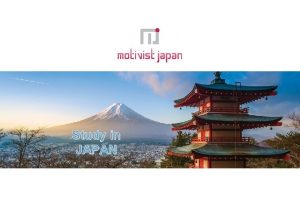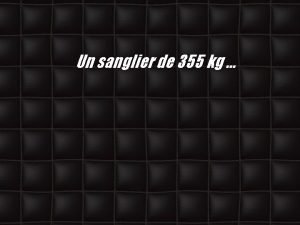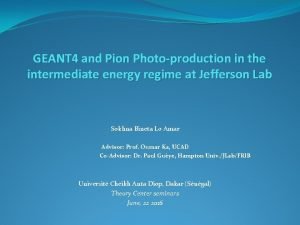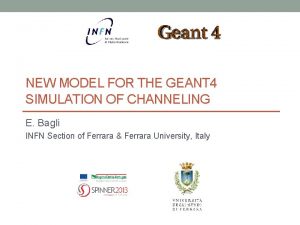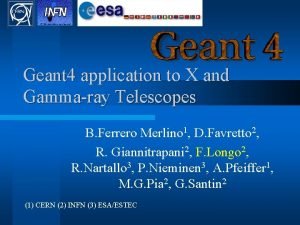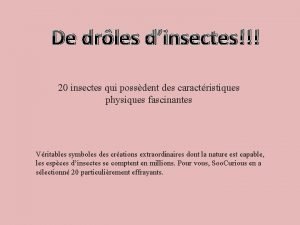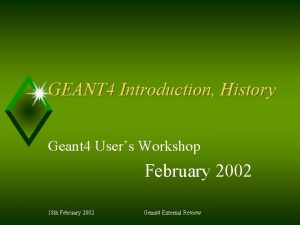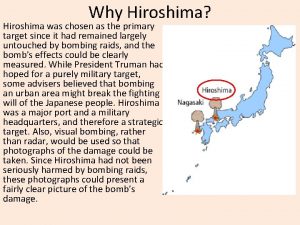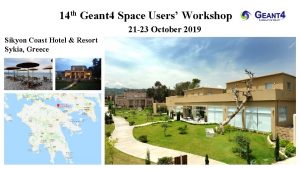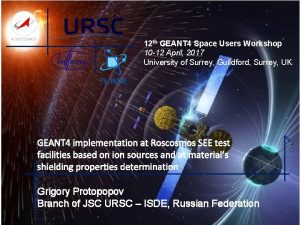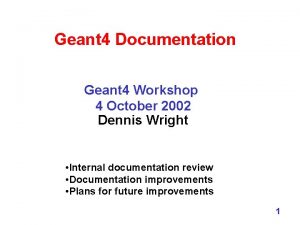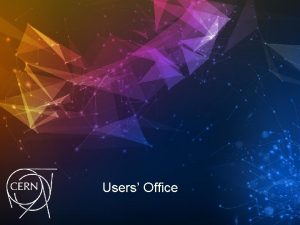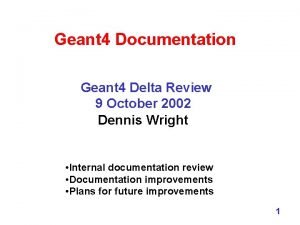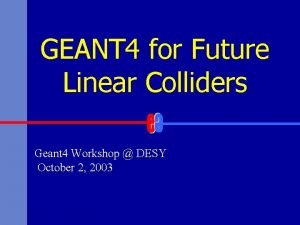11 th Geant 4 Space Users Workshop Hiroshima














- Slides: 14

11 th Geant 4 Space User’s Workshop Hiroshima, 26 -28 Aug 2015 Geant 4 at INTA Status Report - 2015 S. Ibarmia, P. Gallego, C. Martínez

Areas where Geant 4 is applied Since 2004 the INTA Space Environments & Effects group has worked to include Geant 4 as base radiation simulation analysis tool. As a result , Geant 4 is currently supporting activities in the following areas: Space radiation engineering ð At S/C level § § Shielding analysis, radiation level spec. TID, DDD, fluxes, background noise, etc, ð At instrument/payload level § § § Supporting design optimization Shielding & effects estimation Radiation sensor calibration and design Qualification of EEE components irradiation ð Irradiation simulation. Dosimetry estimation ð Effective damage at sub-component level R&D ð Participation in ESA funded R&D specific activities related Geant 4 11 th Geant 4 Space Users’ Workshop Hiroshima, 26 -28 Aug 2015

Geant 4 supported projects ESA Programs ð ð ð Solar Orbiter – PHI instrument Bepi. Colombo – MIXS instrument (ended) Exo. Mars – RLS instrument Plato (new) Athena (new) AIM / COPINS (new) National Nano/Micro missions ð Nanosat-1 B ð OPTOS ð Xat. Cobeo (ended) & Humsat-D ð Nanosat-2, Micro. Sat (planned) Other R&D ð ESA ITT -> CIRSOS 11 th Geant 4 Space Users’ Workshop Hiroshima, 26 -28 Aug 2015

ESA Solar Orbiter - PHI Polarimetric & Helioseismic Imager Development of a polarimetric telescope to study helioseismicity ð Heritage from IMAX/Sun. Rise ð Launch foreseen for 2018+ ð State-of-the-art technologies § Li. NBO 3 etalons to banpass (m. Ang) solar Fe. I line (6173 ang) Geant 4 activities ð Space engineering. Full S/C simulation § § Full CAD to Geant 4 modeling Radiation levels for all PHI components ð Support: simulation of p+ & HI test CAD Designs GEANT 4 Models (CDR) § § Li. Nb. O 3 Etalons (5000 V, roughness <20 nm ) Dose profiling for all optical elements 11 th Geant 4 Space Users’ Workshop Hiroshima, 26 -28 Aug 2015

ESA Bepi. Colombo - MIXS Mercury Imager X-ray Spectrometer INTA is resposible of the development of MIXS Focal Plane and E-Box ð Status: FM completed and delivered to ESA Geant 4 activities Bepi. Colombo MPO G 4 Model ð Space engineering. Full S/C simulation § § Shielding analysis Radiation levels for INTA MIXS components ð X-ray simulation § § § MIXS FM MIXS G 4 Model Calibration sources Mercury X-ray fluorescence X-ray focusing (optics grating MCP ) ð Simulation of the electron diverter (@optics) 11 th Geant 4 Space Users’ Workshop Hiroshima, 26 -28 Aug 2015

ESA Exomars 2018 - RLS Raman Laser Spectrometer INTA is responsible of the development of the entire instrument ð Launch foreseen for 2018+ ð Chemical composition analyser based on laserinduced raman spectroscopy Geant 4 activity ð Space engineering. Instrument simulation § § § Shielding analysis Radiation levels at RLS components Proton & RHU propagation for RLS components ð Irradiation test simulation § Proton and HI tests: Lasers, diffracction gratings and optical lens 11 th Geant 4 Space Users’ Workshop Hiroshima, 26 -28 Aug 2015

ESA PLATO Optical telescope array Detection of terrestrial exoplanets in the habitable zone of solar-type stars INTA is responsible of the development of all the telescopes FPA ð Launch foreseen for 2024 Geant 4 activity ð Phase A/B: § § § Worst-case shielding analysis Radiation levels at critical components Main concern at this stage: Principal CCDs sensitive to TID ~5 krad!! Weight budget on its limit for extra shielding PLATO Telescope Geant 4 Model 11 th Geant 4 Space Users’ Workshop Hiroshima, 26 -28 Aug 2015

ESA ATHENA Next generation X-ray observatory ð Mapping hot gas structures and determining their physical properties ð Searching for supermassive black holes ð INTA will be probably responsible of part of the FPA assembly and cryogenics system ð Launch foreseen for 2028 – Halo orbit L 2 Geant 4 activities ð TBD. Contracts under bidding process ð Challenges for Geant 4: § § § Simulation of background effects. Activation Focusing of unwanted low-energy particles Simulation of Silicon Pore Optics ð Much to learn from Astro-H Geant 4 work 11 th Geant 4 Space Users’ Workshop Hiroshima, 26 -28 Aug 2015

ESA AIM / COPINS AIM: Asteroid Impact Mission ð Part of the Asteroid Impact & Deflection Assessment mission (AIDA). ð Launch foreseen for 2020 ð Study the Didymos binary asteroid system ð INTA has been selected fot a feasibility study – COPINS (Cube. Sat Opportunity Payloads) § Responsible for two Cube. SATs Geant 4 activities ð TBD. Overall radiation level and shielding assessments 11 th Geant 4 Space Users’ Workshop Hiroshima, 26 -28 Aug 2015

INTA Nanosat-1 B Nanosat 1 B mission ð Second sattelite of the nanosat series ð Launched in summer 2009, sun-synchronous, 600 km ð Radiation payloads § LDT (results to be published) § § Geant 4 model of NS 1 B (80 -85% mass, 100’s vols, high fidelity) § A photodiode-based TNID sensor (Dark current) Particle flux measurements (Photocurrent) High sensitivity Rad. FET TID sensors § § § Direct readout data ~150 rad/year Compensated with annealing ~200 rad/year Geant 4 + NS 1 B Model ~240 ± 20 rad/year Geant 4 activities ð Space engineering. § § Shielding analysis Radiation levels at EEE, OWLS, LDT and Rad. FETs ð Simulation of LDT calibration tests under proton (PSI) Location of LDT and Rad. FET 11 th Geant 4 Space Users’ Workshop Hiroshima, 26 -28 Aug 2015

INTA Nanosat-1 B Simulation of LDT calibration campaigns LDT Developed by INTA Optoelectronics Lab Measurement results vs. Simulation under publication and Ph. D thesis Geant 4 model, 70 Me. V proton irradiation and energy thresholds for <DT detectors. 11 th Geant 4 Space Users’ Workshop Hiroshima, 26 -28 Aug 2015

OPTOS, Xat. Cobeo, Hum. SAT-D OPTOS ð 3 U Cube. SAT – Technological demonstrator ð Launched on November 2013 ð Radiation payloads: High sensitivity Rad. FET sensor Xat. Cobeo mission ð 3 U Cube. SAT – University of Vigo & INTA ð Launched on Feb 2012 (VEGA maiden flight) ð Radiation payloads: High sensitivity TNID sensor Hum. SAT-D mission ð Evolution of Xat. Cobeo. Same 1 U platform ð Launched on November 2013 ð Radiation payloads: High sensitivity TNID sensor ð S/C full Geant 4 modeling for shielding analysis & radiation levels estimation Geant 4 activity ð Validation of environment models, margins analysis ð Results under final publication process! 11 th Geant 4 Space Users’ Workshop Hiroshima, 26 -28 Aug 2015

R&D: CIRSOS Collaborative Iterative Radiation Shielding Optimisation System (CIRSOS) The CIRSOS system is an ESA funded R&D project aimed to develop a full radiation simulation framework, in order to help S/C and P/L engineers, through a SW system that: ð Efficiently supports collaborative and iterative radiation analyses ð Provides interfaces with industrial radiation design tools ð Allows end-to-end radiation simulation, starting from the definition of the high energy particle environment, performing particle propagation through complex 3 D geometrical models (via Geant 4) and ending with deep dielectric charging effects modelling (via SPIS) Se e Fr id ay ta lk !! Some of the most relevant advantages of CIRSOS for the radiation community include: § § § § A user-friendly GUI to manage the entire system A database controlled geometry managing. Material properties built-in databases High-energy radiation and charging simulation capabilities (independent or coupled) Parametric Geant 4 analyses Interface to SPENVIS, OMERE, FASTRAD and ESABASE 2 Parallel simulation on multiple host / multiple processor Built-in post-processing tools, bilt-in geometry visualization tools 11 th Geant 4 Space Users’ Workshop Hiroshima, 26 -28 Aug 2015

Summary & Future Summary ð INTA is applying Geant 4 as standard radiation tool § Many different programs supported § Establishing G 4 as the standard methodology for radiation analysis ð Main scenarios of successful application § Engineering support to ESA instruments § Engineering support to INTA missions § Payload design and calibration of radiation sensors § Other Geant 4 R&D focused on the improvement and/or development of new engineering tools 11 th Geant 4 Space Users’ Workshop Hiroshima, 26 -28 Aug 2015
